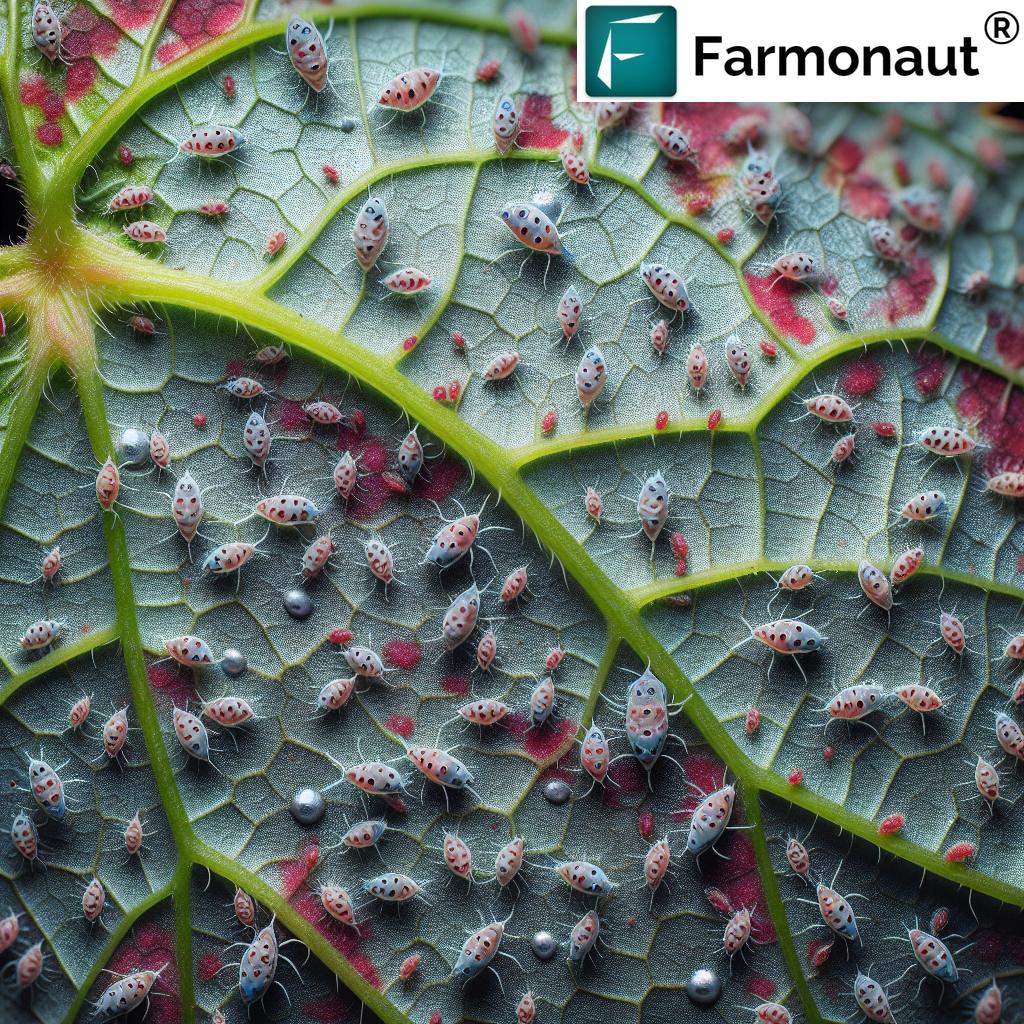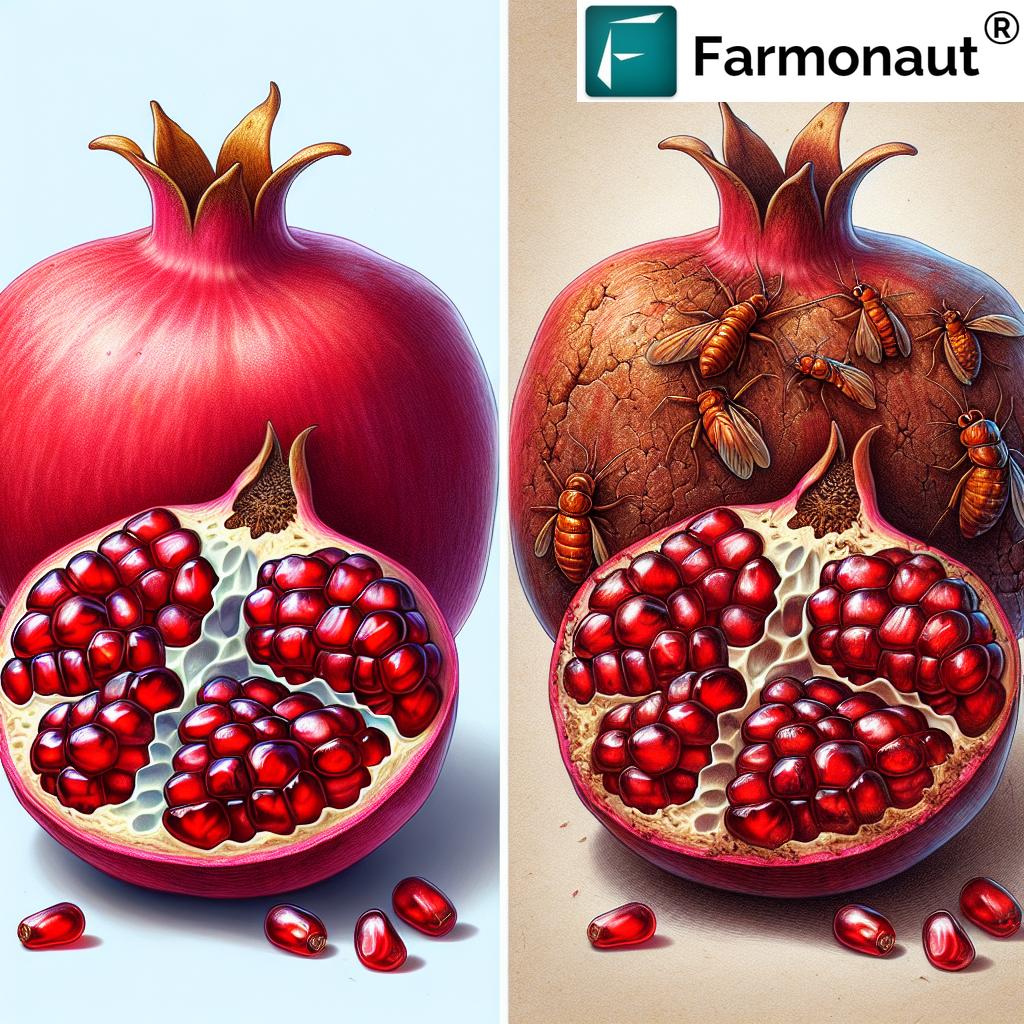Thrips Control: Protecting Crops from Red Leaves to Silvery Patches in Grapevines, Pomegranate, and More

At Farmonaut, we understand the critical importance of protecting crops from various pests and diseases. Among these, thrips have emerged as a significant concern for farmers worldwide, affecting a wide range of crops including grapevines, pomegranate, persimmon, avocado, cotton, roses, myrtle, and soy. These tiny insectos (insects) can cause substantial damage to plants, leading to reduced yields and economic losses. In this comprehensive guide, we’ll explore the world of thrips, their impact on different crops, and how our advanced satellite-based technology can help in early detection and effective control.
Understanding Thrips: The Tiny Terrors of Agriculture
Thrips are minute insects belonging to the order Thysanoptera. Despite their small size, typically less than 2mm in length, they can cause significant damage to crops. These pests are known for their rapid reproduction and ability to quickly establish large colonies on host plants.
Life Cycle of Thrips
The life cycle of thrips consists of several stages:
- Egg: Females lay eggs inside plant tissues.
- Nymphs: After hatching, thrips go through two nymphal stages.
- Prepupa and Pupa: These non-feeding stages occur in soil or plant debris.
- Adult: The mature thrips emerge, ready to feed and reproduce.
Understanding this life cycle is crucial for implementing effective control measures at the right time.
The Impact of Thrips on Various Crops
Thrips can affect a wide range of crops, each with its unique set of symptoms and challenges. Let’s explore how these pests impact some of the most commonly affected crops:
1. Grapevines
Thrips infestation in grapevines can lead to:
- Distorted and stunted shoot growth
- Scarring on berries
- Reduced fruit quality and yield
2. Pomegranate
In pomegranate orchards, thrips can cause:
- Scarring on fruit surfaces
- Discoloration of arils
- Reduced marketability of fruits
3. Persimmon
Thrips damage on persimmon trees may include:
- Leaf curling and distortion
- Fruit scarring
- Premature fruit drop
4. Avocado
In avocado orchards, thrips can lead to:
- Scarring on fruit skin
- Reduced fruit size
- Leaf distortion and discoloration
5. Cotton
Cotton plants affected by thrips may show:
- Silvery or bronze discoloration of leaves
- Stunted growth
- Reduced yield and quality
6. Roses
In rose gardens, thrips can cause:
- Distorted and discolored blooms
- Streaking on petals
- Reduced aesthetic value
Identifying Thrips Damage: Key Symptoms to Watch For
Recognizing the signs of thrips infestation early is crucial for effective control. Here are some common symptoms to look out for across various crops:
1. Leaf Discoloration
One of the most noticeable signs of thrips damage is the change in leaf color. Affected leaves may turn:
- Red: Particularly in young leaves or shoots
- Brown: Often seen as bronzing on mature leaves
- Black: In severe cases, leaves may develop necrotic spots
2. Silvery Patches
As thrips feed on plant cells, they often leave behind characteristic silvery patches on leaves, fruits, and flowers. These patches are actually areas where the cells have been emptied of their contents, leaving a reflective surface.
3. Distorted Growth
Thrips feeding can lead to various growth abnormalities:
- Curled or twisted leaves
- Stunted shoots
- Malformed fruits
4. Scarring on Fruits
Many fruits affected by thrips will show visible scarring on their surface. This not only reduces their aesthetic appeal but can also impact their market value.
The Role of Farmonaut in Early Thrips Detection

At Farmonaut, we leverage advanced satellite technology to provide early detection of thrips infestations. Our system can identify subtle changes in crop health that may indicate the presence of these pests before visible symptoms become apparent to the naked eye.
How Farmonaut’s Satellite Imagery Detects Thrips Damage
- Spectral Analysis: Our satellites capture multispectral images that can detect changes in plant health not visible to the human eye.
- Vegetation Indices: We use specialized algorithms to analyze vegetation indices, which can highlight areas of stress in crops.
- Pattern Recognition: Our AI-powered system can identify patterns consistent with thrips damage across large areas.
- Temporal Monitoring: By comparing images over time, we can detect progressive changes that may indicate an emerging thrips infestation.
To illustrate the effectiveness of our system, let’s look at a comparison table of thrips damage symptoms on different crops and how Farmonaut’s satellite imagery can detect these symptoms early:
| Crop Type | Visible Symptoms | Farmonaut’s Detection Capabilities |
|---|---|---|
| Grapevines | Red leaves, stunted shoots, scarred berries | Early detection of leaf discoloration and growth abnormalities |
| Pomegranate | Fruit scarring, discolored arils | Identification of stress patterns in fruit-bearing areas |
| Avocado | Leaf distortion, fruit scarring | Detection of canopy irregularities and fruit development issues |
| Cotton | Silvery patches on leaves, stunted growth | Early identification of reflectance changes in leaf surfaces |
| Roses | Distorted blooms, petal streaking | Detection of spectral changes in flower beds indicative of stress |
By utilizing Farmonaut’s advanced satellite imagery, farmers can gain a significant advantage in the early detection and management of thrips infestations across various crop types.
Effective Thrips Control Strategies
Once thrips have been detected, implementing effective control measures is crucial. At Farmonaut, we advocate for an integrated pest management (IPM) approach that combines various strategies for optimal results:
1. Cultural Control
- Crop Rotation: Alternating susceptible crops with non-host plants can break the thrips life cycle.
- Sanitation: Removing crop debris and weeds can eliminate thrips breeding sites.
- Proper Irrigation: Maintaining optimal soil moisture can help plants withstand thrips damage better.
2. Biological Control
Encouraging natural predators can help keep thrips populations in check:
- Predatory mites
- Lacewings
- Minute pirate bugs
3. Chemical Control
When necessary, targeted application of insecticides can be effective:
- Systemic insecticides for long-term protection
- Contact insecticides for immediate control
- Always follow label instructions and local regulations
4. Physical Barriers
In some cases, physical barriers can prevent thrips from reaching crops:
- Reflective mulches
- Insect-proof screens in greenhouses
- Sticky traps for monitoring and control
Farmonaut’s Integrated Approach to Thrips Management
At Farmonaut, we believe in a holistic approach to pest management. Our satellite-based technology works in conjunction with on-ground practices to provide comprehensive thrips control:
- Early Detection: Our satellite imagery can identify potential thrips infestations before visible symptoms appear.
- Precision Targeting: By pinpointing affected areas, we help farmers apply control measures more efficiently.
- Monitoring Effectiveness: Our continuous monitoring allows farmers to assess the efficacy of their control strategies in real-time.
- Data-Driven Decision Making: We provide actionable insights based on historical data and current conditions to optimize pest management strategies.
To access our advanced satellite monitoring services and take your thrips control to the next level, visit Farmonaut’s App.
Case Studies: Successful Thrips Control with Farmonaut
While we don’t provide specific case studies or success stories, we can share general observations on how our technology has aided in thrips control across various crops:
Grapevines in California
Our satellite imagery helped identify early signs of thrips infestation in a large vineyard, allowing for targeted treatment and preventing widespread damage.
Pomegranate Orchards in Spain
Farmonaut’s technology detected stress patterns consistent with thrips damage, enabling prompt intervention and preserving fruit quality.
Cotton Fields in India
Our system’s ability to detect subtle changes in leaf reflectance led to early thrips control measures, resulting in improved yield and quality.
The Future of Thrips Control: Integrating Technology and Traditional Practices
As we look to the future, the integration of advanced technology like Farmonaut’s satellite imagery with traditional agricultural practices holds great promise for effective thrips control. Here are some emerging trends and possibilities:
1. AI-Powered Predictive Models
By analyzing historical data and current environmental conditions, AI algorithms could predict potential thrips outbreaks before they occur, allowing for preemptive measures.
2. Drone-Based Precision Application
Combining satellite data with drone technology could enable ultra-precise application of control measures, minimizing environmental impact and maximizing effectiveness.
3. IoT Sensors for Microclimate Monitoring
Internet of Things (IoT) sensors could provide real-time data on microclimatic conditions favorable to thrips, integrating seamlessly with Farmonaut’s satellite imagery for comprehensive monitoring.
4. Genetic Resistance
Advances in plant breeding and genetic engineering may lead to crop varieties with enhanced resistance to thrips, which could be identified and monitored using our satellite technology.
Farmonaut’s Commitment to Sustainable Agriculture
At Farmonaut, we’re committed to promoting sustainable agricultural practices. Our thrips control strategies aim to minimize environmental impact while maximizing crop protection:
- Reducing pesticide use through precise targeting
- Promoting biological control methods
- Encouraging biodiversity in agricultural ecosystems
- Optimizing resource use through data-driven decision making
By choosing Farmonaut, you’re not just protecting your crops from thrips; you’re contributing to a more sustainable future for agriculture.
How to Get Started with Farmonaut
Ready to take your thrips control to the next level with Farmonaut’s advanced satellite technology? Here’s how you can get started:
- Download Our App: Available on Google Play and the App Store.
- Create Your Account: Sign up and enter your farm details.
- Choose Your Subscription: Select the plan that best fits your needs.
- Start Monitoring: Begin receiving insights and alerts about your crop health, including potential thrips infestations.
For developers interested in integrating our technology into their own systems, check out our API documentation.
Frequently Asked Questions (FAQ)
Q: How effective is satellite imagery in detecting thrips damage?
A: Satellite imagery is highly effective in detecting early signs of thrips damage, often before visible symptoms appear. Our technology can identify subtle changes in plant health indicative of thrips infestation with high accuracy.
Q: Can Farmonaut’s technology distinguish between thrips damage and other pest issues?
A: While our technology can detect plant stress patterns consistent with thrips damage, definitive pest identification often requires on-ground verification. However, our system can significantly narrow down the potential causes of crop stress, making pest management more efficient.
Q: How often does Farmonaut update its satellite imagery?
A: The frequency of updates depends on the subscription plan chosen. We offer plans with updates ranging from daily to weekly, ensuring you have access to the most current data for your needs.
Q: Is Farmonaut’s technology suitable for small-scale farmers?
A: Absolutely! We have tailored our services to be accessible and affordable for farmers of all scales, from small family farms to large commercial operations.
Q: How does Farmonaut integrate with existing farm management practices?
A: Farmonaut is designed to complement and enhance existing farm management practices. Our insights can be easily incorporated into your current decision-making processes, helping to optimize your thrips control strategies.
Conclusion: Empowering Farmers in the Fight Against Thrips
Thrips may be tiny, but their impact on crops can be enormous. From the red leaves of grapevines to the silvery patches on cotton plants, these pests pose a significant challenge to farmers worldwide. However, with Farmonaut’s advanced satellite technology, farmers now have a powerful ally in the fight against thrips.
By providing early detection, precise monitoring, and data-driven insights, we empower farmers to take proactive measures against thrips infestations. Our technology not only helps protect crops but also promotes more sustainable and efficient agricultural practices.
As we continue to innovate and improve our services, we remain committed to our mission of making precision agriculture accessible to all. Together, we can build a future where thrips control is more effective, sustainable, and economically viable for farmers everywhere.
Ready to revolutionize your approach to thrips control? Subscribe to Farmonaut today and take the first step towards smarter, more effective pest management.
Join us in the fight against thrips and unlock the full potential of your crops with Farmonaut’s cutting-edge satellite technology.